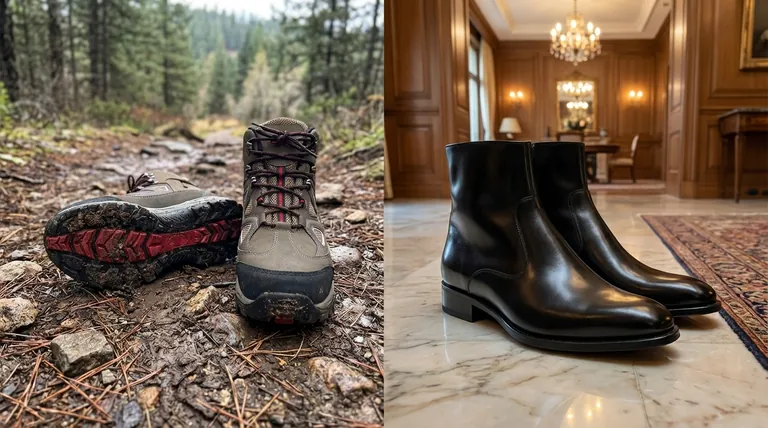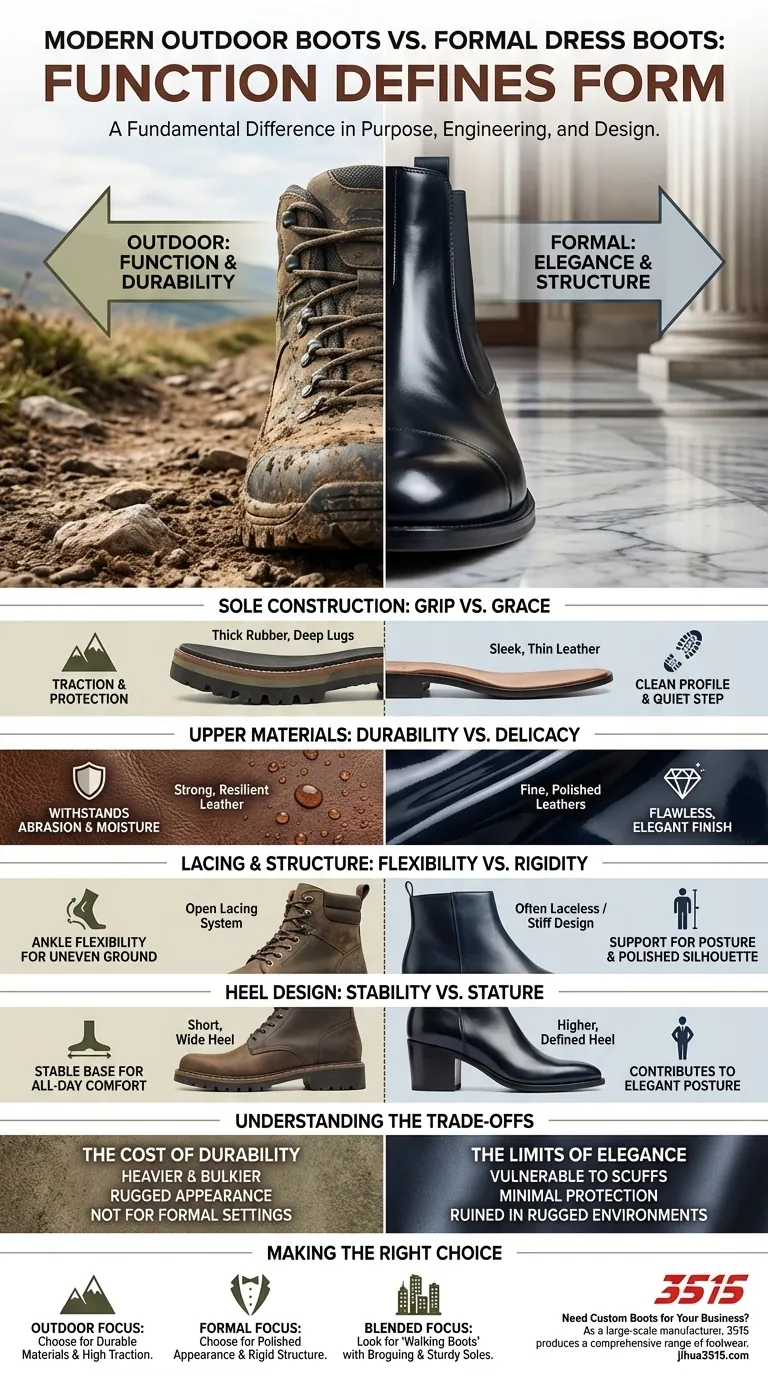The fundamental difference between modern outdoor boots and formal dress boots lies in their core purpose: outdoor boots are engineered for function and durability, while formal boots are designed for elegance and structure. Outdoor boots prioritize practicality with features like thick rubber soles and flexible lacing, whereas dress boots emphasize a polished, rigid appearance suitable for specific, controlled environments.
While both boot types share a common ancestry, their evolution has split them into two distinct categories: one serving as a rugged tool for demanding environments, and the other as a refined accessory for formal occasions. Understanding this core distinction between function and form is key to selecting the right footwear.

The Anatomy of a Boot: Function Defines Form
Every component of a boot is a deliberate choice that reflects its intended use. The differences are not arbitrary; they are solutions to different problems, whether that problem is navigating a rocky trail or maintaining perfect posture in a formal setting.
Sole Construction: Grip vs. Grace
An outdoor boot's sole is its connection to unpredictable terrain. It often features double leather or thick rubber soles with deep lugs for traction and protection. This construction is built to absorb impact and resist wear.
A formal dress boot, by contrast, typically has a sleeker, thinner leather sole. The focus is on a clean profile and a quiet step, not on all-weather grip.
Upper Materials: Durability vs. Delicacy
Outdoor and work boots are made from strong, resilient leather, and sometimes even tougher materials like cordovan. The material is chosen for its ability to withstand abrasion, moisture, and repeated stress.
Formal dress boots use fine, polished leathers. The goal is a flawless, elegant finish, which often comes at the expense of the rugged durability required for outdoor use.
Lacing and Structure: Flexibility vs. Rigidity
Many outdoor and field boots feature open lacing systems that extend down to the vamp (the front part of the foot). This design provides crucial ankle flexibility, essential for walking on uneven ground or for riders in jumping disciplines.
Conversely, many formal dress boots, particularly in equestrian styles like dressage, lack lacing entirely. They are intentionally designed to be stiffer and more rigid, providing support for a specific posture and creating a seamless, polished silhouette.
Heel Design: Stability vs. Stature
Work boots, a subset of outdoor boots, typically have a short, wide heel. This provides a stable base and ensures comfort during long hours of standing and walking on hard surfaces.
Formal dress boots often feature a higher, more defined heel. This detail contributes to a more elegant posture and is a key element of their formal aesthetic, rather than a choice made for all-day comfort.
Understanding the Trade-offs
Choosing between these boot styles involves accepting a clear set of compromises. Neither is inherently "better"; they are simply optimized for different contexts.
The Cost of Durability
The robust construction of an outdoor boot makes it heavier and bulkier. Its rugged appearance, while practical for the field, is out of place in a formal or business setting. The materials and soles are designed for performance, not for subtlety.
The Limits of Elegance
The refined nature of a formal dress boot makes it vulnerable. Its polished leather can easily scuff, and its thin sole offers minimal protection and traction. Wearing a dress boot in a rugged environment will not only be uncomfortable but will likely ruin the boot.
Making the Right Choice for Your Goal
Your primary activity should be the deciding factor. The boot must match the environment it will be used in.
- If your primary focus is outdoor activity or manual labor: Choose an outdoor or work boot for its durable materials, high-traction sole, and flexible support.
- If your primary focus is formal events or dressage: A dress boot is the correct choice for its polished appearance and rigid structure designed for posture and form.
- If your primary focus is blending style with daily wear: Look for "walking boots" or "country boots" that incorporate elements like broguing and sturdy soles without being as bulky as a dedicated hiking boot.
Ultimately, selecting the right boot is about aligning the tool with the task at hand.
Summary Table:
| Feature | Outdoor Boots | Formal Dress Boots |
|---|---|---|
| Primary Purpose | Function & Durability | Elegance & Structure |
| Sole Construction | Thick rubber, deep lugs for traction | Sleek, thin leather for a clean profile |
| Upper Materials | Strong, resilient leather (e.g., cordovan) | Fine, polished leathers |
| Lacing System | Open lacing for ankle flexibility | Often laceless for rigidity and polish |
| Heel Design | Short, wide for stability | Higher, defined for posture and elegance |
Need Custom Boots for Your Business?
As a large-scale manufacturer, 3515 produces a comprehensive range of footwear for distributors, brand owners, and bulk clients. Whether you require rugged outdoor boots built for performance or elegant dress boots crafted for style, our production capabilities encompass all types of shoes and boots to meet your exact specifications.
Let's discuss your project: Contact our team today to explore how we can deliver quality, durability, and style for your customers.
Visual Guide

Related Products
- Safety Footwear Wholesale Manufacturer for Custom OEM/ODM Production
- Wholesale Safety Footwear Manufacturer for Bulk & Custom OEM Orders
- High Performance Fire-Retardant Waterproof Safety Boots
- Factory-Direct Wholesale Canvas Boots with High-Traction Rubber Soles
- Premium Wholesale Waterproof Safety Boots High Performance Protection for Industrial Markets
People Also Ask
- What are OSHA approved shoes? Understanding the Correct Standards for Workplace Safety
- How do safety shoes contribute to cost savings for companies? A Strategic Investment in Risk and Cost Management
- Do snake bite boots work? Your Ultimate Guide to Effective Snake Bite Protection
- What are the differences between steel toe, composite toe, and alloy toe Wellington boots? Choose the Right Safety Toe for Your Job
- How long can you wear safety boots? The Lifespan is Determined by Wear, Not Time



















